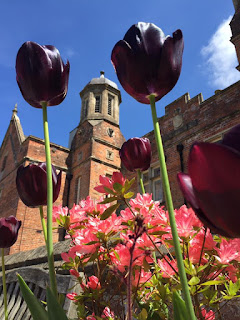The Beautiful Lie, Human Beauty & Oscar Wilde
The Beautiful Lie
I recently came across Oscar Wilde’s famous argument in the “Decay of Lying,” his belief “life imitates art far more than art imitates life” (Wilde n.d). I gathered from Wilde that what humans perceive as beautiful consummates life -- the sensual beauty of experience. I have been thinking about this Socratic dialogue, and its influence on me in reading Jane Hirshfield’s “Poetry, Permeability, and Healing.” One can surmise that beauty is “held in the eye of the beholder.” Wilde contends that all art is a lie, a perfected facsimile of nature; arguing an inverse relationship -- art as the original experience to natural beauty. Albert Goldbarth describes this effect in his poem “Human Beauty.” Art, poetry, life occurs when we mutually agree to acknowledge “what it was a praise of” (Goldbarth, 2004). The perception of art becomes integrated with the human experience; our experience determines our perception of life. And our perception of life is wholly inclusive of art — human beauty. In this way, art is the holding space for relatable perceptions — a permeation of a collective consciousness.
A permeation of a collective consciousness
Healing, according to Hischfield, is borne “by a poem’s held beauty, our held terrors become bearable” (2007). Our terrors are a product of our experience, a dormant fragmentation of a memory, defined by previous definitions. Poetically, Goldbarth shares: “the death is a terrible fire, // the poem is an offering of paper cutout flames // you feed to the fire” (Goldbarth 2004). As in the mustard seed parable — “finding no one who has escaped mourning and loss” (Hirshfield 2007), poems offer universal empathy. A compassionate binary, “poetry’s evidence tells us that we are not singled out by our suffering; we are brought into the shared life of all who have lived and died before and with us” (Hirschfield, 2007). We heal not because of the words, we heal because of the meaning given to us by those around us. The emotional pain diminishes with the elevation of collective actualization.
The elevation of collective actualization
Words are facts, an entry in a dictionary; an evaluation by a “rational mind… unimpassioned and compartmental” (Hirschfield 2007). Poetry goes beyond the rational and permeates the emotional, harnessing the power of shared experience. As Wilde suggests, “if something cannot be done to check, or at least to modify, our monstrous worship of facts, art will become sterile and beauty will pass away from the land” (n.d). Words, alone, are arid, sterile temporality. Words with meaning are “the space between the gestures and the power they address” (Goldbarth 2004) — humanly relatable, humanely compatible, compassionately wholesome.
humanly relatable, humanely compatible, compassionately wholesome
Poems “move the psyche” as an agency for healing (Hirschfield). Love then becomes something folded internally and is externally appreciable for its beauty. Poetry internally structures itself by its words, and externally appreciated for its message. Healing must happen internally, and be liberated for the greater good. This is the healing permeation of poetry. Albert Goldbarth’s poem “Human Beauty” speaks of poetry as if we start with a blank piece of paper, when in love, poetry folds into something beautiful; in death, poetry is an offering of flames; and in the depths of living, we lose poetry inside nature — inside the beautiful lie Wilde defends.
Move the Psyche, Behold as Art
Inherent to poetry (or art of any sort) is a space between the creation and the human, “an insufficiency,” a lie. It is the space of transformation by external forces. Never again can the page be smooth, but it becomes a “repair without denial. It may be that any fully rounded truth, seen without denial, will appear to us as beauty” (Hirschfield 2007). Accepting the damage to the original, made whole through poetry, the human psyche repairs itself, now seen as beautiful for its damage, an exemplary vessel beheld as art.
Human Beauty
by Albert Goldbarth (2004)
If you write a poem about love...
the love is a bird,
the poem is an origami bird.
If you write a poem about death...
the death is a terrible fire,
the poem is an offering of paper cutout flames
you feed to the fire.
We can see, in these, the space between
—an insufficiency. And yet a kind of beauty,
a distinctly human beauty. When a winter storm
from out of nowhere hit New York one night
in 1892, the crew at a theater was caught
unloading props: a box
of paper snow for the Christmas scene got dropped
and broken open, and that flash of white
confetti was lost
inside what it was a praise of.
Read Here:
References
Goldbarth, A. (2004, May). Human Beauty. Retrieved July 02, 2021, from https://www.poetryfoundation.org/poetrymagazine/browse?contentId=42152
Hirshfield, J. (2018, July 1). Poetry, Permeability, and Healing. Retrieved June 29, 2021, from https://poets.org/text/poetry-permeability-and-healing
Wilde, O. (n.d.). The decay of Lying quotes by Oscar Wilde. Retrieved July 03, 2021, from https://www.goodreads.com/work/quotes/1439639-the-decay-of-lying






Comments
Post a Comment